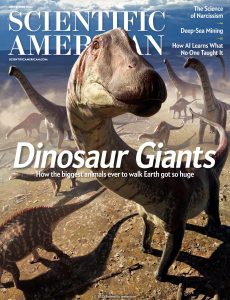
Scientific American – September 2023
English | 112 pages | pdf | 26.18 MB
Welcome at Scientific American Magazine September 2023 Issue
Do you know someone who is a narcissist? You probably do—an estimated 6 percent of the population has at some point fit the criteria for narcissistic personality disorder. It’s a difficult condition to diagnose, in part because many people who have it think they’re just fine (or exceptional) the way they are, and they don’t seek help. The researchers who study the condition and the therapists who treat it tend to disagree about some of the fundamental characteristics of narcissism. They agree that there seem to be two main expressions of narcissism: grandiosity and vulnerability.
They disagree about whether these two primary characteristics always overlap or whether grandiosity can exist on its own. As writer Diana Kwon explains on page 52, new research, including brain imaging, is starting to resolve some of the big questions about narcissism. Sauropods, like narcissists, are difficult to study. You’d think the largest land animals in the history of Earth would be prominent in the fossil record, but their bones tended to scatter, and it’s tough to get a lot of data when each femur requires a forklift to move. (In case you’re wondering, blue whales are almost as long as the longest sauropods, but they weigh much more because the effect of gravity is different in water.) Paleontologist Michael D. D’Emic recently analyzed sauropod size around the world and found that different lineages evolved into giants three dozen times.
In our cover story starting on page 26, he theorizes about how and why they grew so big. Enjoy the many dino illustrations included. One thing I think all of us at Scientific American love about our jobs is that we learn something new every day. I hadn’t known about the Clarion-Clipperton Zone (CCZ) of the Pacific before this issue, for example, but we could all be hearing much more about it in the next year. Deep-sea mining operations want to harvest the CCZ’s potato-size nodules containing valuable metals. The problem is that the CCZ is pristine, barely explored and full of unknown species that could be valuable in their own right. Scientists are rushing to understand the ecosystem and the potential impacts of mining, as journalist Olive Heffernan shares on page 34, and the International Seabed Authority has to decide soon whether to allow massive dredging of this unique environment. Artificial-intelligence systems also learn, in a way—and it’s a way we don’t entirely understand. As Scientific American Magazine contributing editor George Musser describes on page 58, AIs seem to build a model of the world. This representation allows them to make connections and express knowledge that goes well beyond what they were trained to do. Stay tuned. Dementia can increase the risk of criminal behavior, and the justice system is poorly equipped to handle such cases. On page 62, writer Jessica Wapner narrates the story of one defendant who did the crime (health-care fraud)—but to what extent was he responsible? Some experts are calling for a special court system for people with cognitive decline, modeled on the juvenile justice system. Some of the most spectacular stars in the universe are called Wolf-Rayets. They’re enormous, hot, rare and dramatic—the final stage in an enormous star’s fast-burning life before it goes supernova. Astronomer Peter Tuthill ( page 44 ) has found some fascinating Wolf-Rayets, and he and his colleagues are now using James Webb Space Telescope images to understand their fine structure and fate.
Here’s some great news as we head into the fall: vaccines for respiratory syncytial virus, or RSV, are now available for older adults, and new treatments are available for infants. On page 70, journalist Tara Haelle spells out the history of research that led to these advances. RSV is a nasty virus that kills more than 14,000 people in the U.S. every year, and we hope this work will save many lives.
Download from:
One Response to “Scientific American – September 2023”
Warning: call_user_func_array() expects parameter 1 to be a valid callback, function 'embed_bbcode ' not found or invalid function name in /home/magdownload/public_html/wp-includes/class-wp-hook.php on line 310